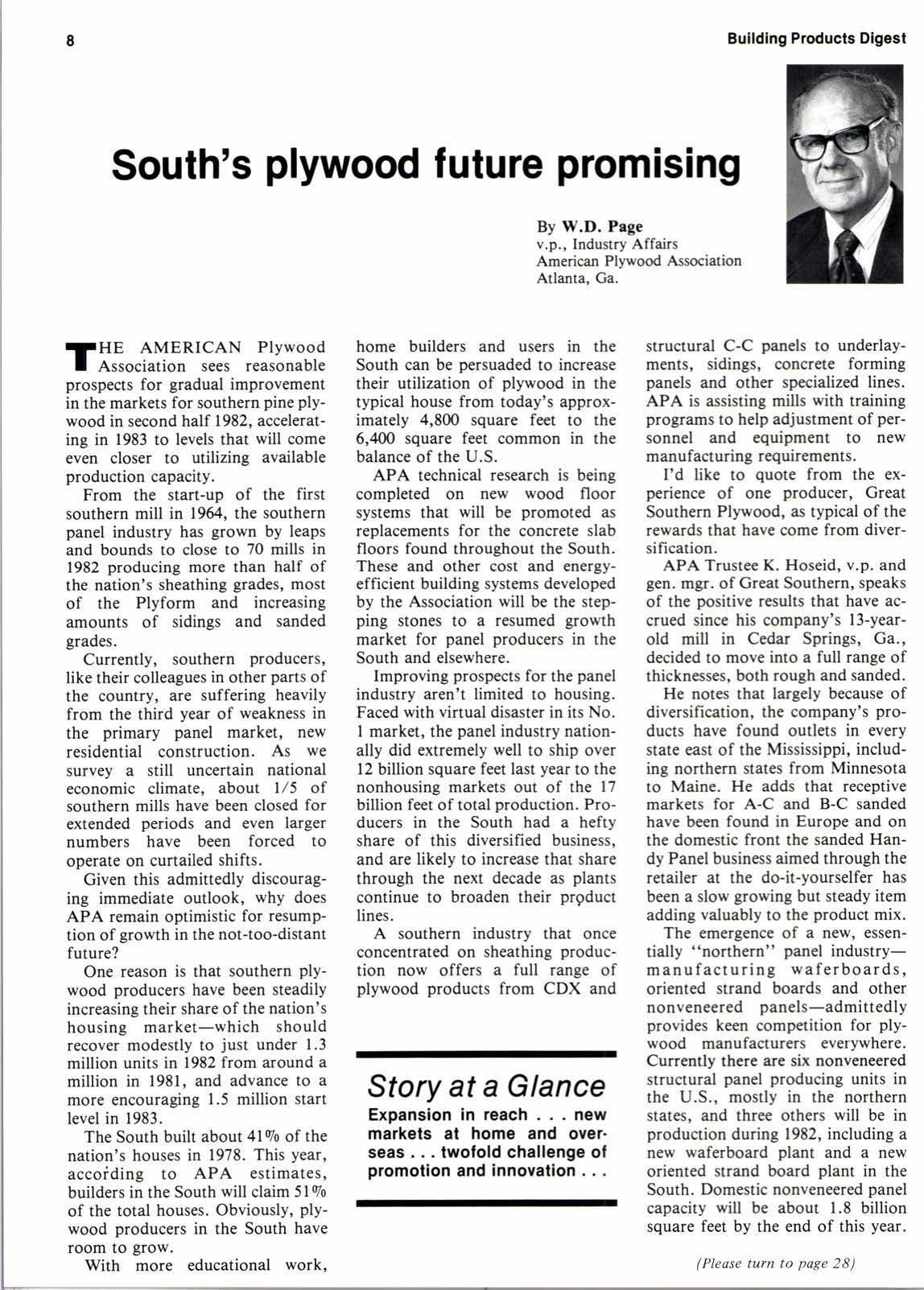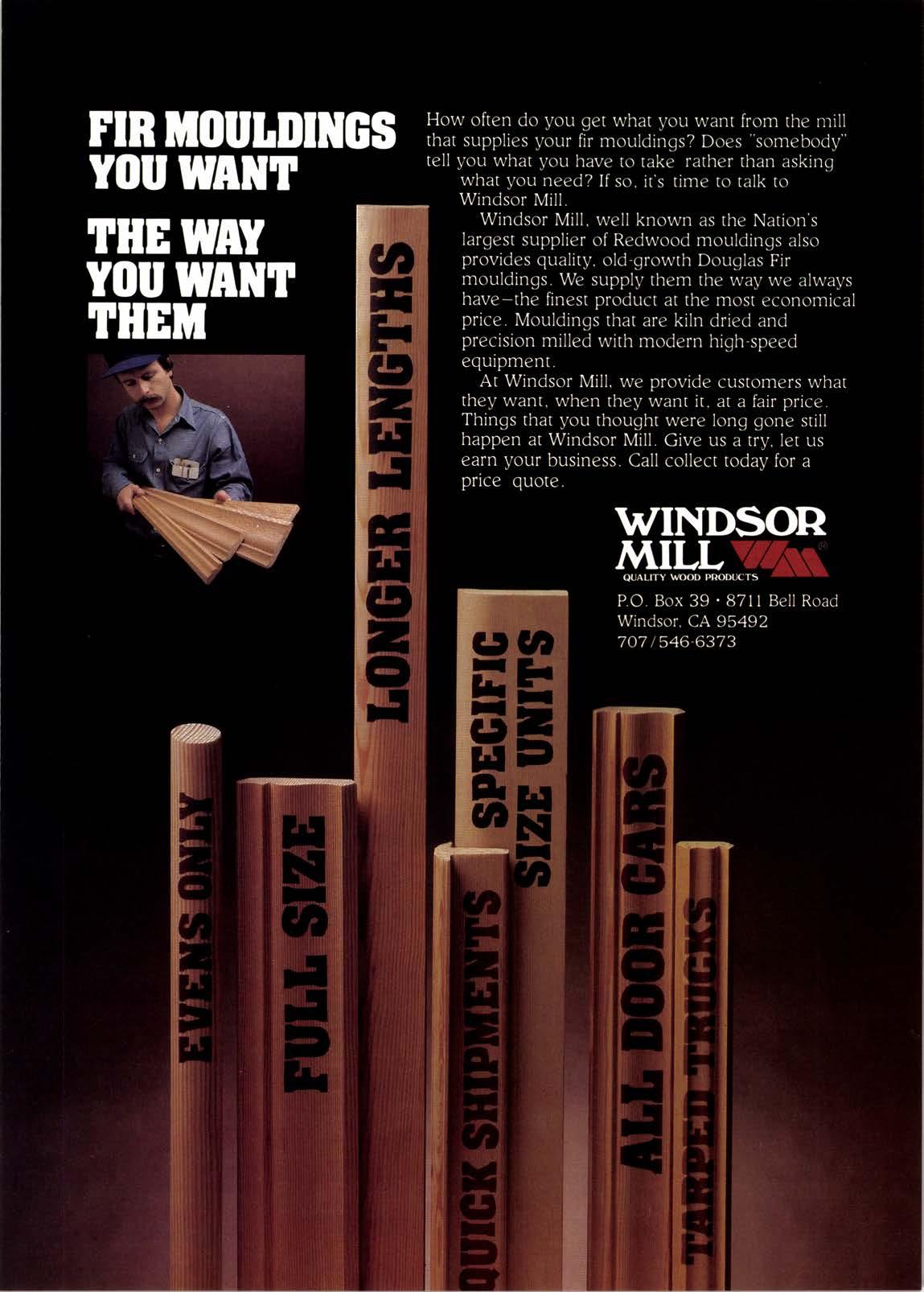
3 minute read
South's plywood future promising
By W.D. Page v.p., Industry Affairs American Plywood Association Atlanta, Ga.
?HE AMERICAN Plywood
I Association sees reasonable prospects for gradual improvement in the markets for southern pine plywood in second half 1982, accelerating in 1983 to levels that will come even closer to utilizing available production capacity.
From the start-up of the first southern mill in 1964. the southern panel industry has grown by leaps and bounds to close to 70 mills in 1982 producing more than half of the nation's sheathing grades, most of the Plyform and increasing amounts of sidings and sanded grades.
Currently, southern producers, like their colleagues in other parts of the country, are suffering heavily from the third year of weakness in the primary panel market, new residential construction. As we survey a still uncertain national economic climate, about l/5 of southern mills have been closed for extended periods and even larger numbers have been forced to operate on curtailed shifts.
Given this admittedly discouraging immediate outlook, why does APA remain optimistic for resumption of growth in the not-too-distant future?
One reason is that southern PIYwood producers have been steadily increasing their share of the nation's housing market-which should recover modestly to just under 1.3 million units in 1982 from around a million in 1981, and advance to a more encouraging 1.5 million start level in 1983.
The South built about 419o of the nation's houses in 1978. This year, accoiding to APA estimates, builders in the South will claim 5l9o of the total houses. Obviously, plywood producers in the South have room to grow.
With more educational work, home builders and users in the South can be persuaded to increase their utilization of plywood in the typical house from today's approximately 4,800 square feet to the 6,400 square feet common in the balance of the U.S.
APA technical research is being completed on new wood floor systems that will be promoted as replacements for the concrete slab floors found throughout the South. These and other cost and energyefficient building systems developed by the Association will be the stepping stones to a resumed growth market for panel producers in the South and elsewhere.
Improving prospects for the panel industry aren't limited to housing. Faced with virtual disaster in its No. I market, the panel industry nationally did extremely well to ship over 12 billion square feet last year to the nonhousing markets out of the 17 billion feet of total production. Producers in the South had a hefty share of this diversified business, and are likely to increase that share through the next decade as plants continue to broaden their prgduct lines.
A southern industry that once concentrated on sheathing production now offers a full range of plywood products from CDX and
Story at a Glance
Expansion in reach . . . new markets at home and overseas . . twolold challenge of promotion and innovation structural C-C panels to underlayments, sidings, @ncrete forming panels and other specialized lines. APA is assisting mills with training programs to help adjustment of personnel and equipment to new manufacturing requirements.
I'd like to quote from the experience of one producer, Great Southern Plywood, as typical of the rewards that have come from diversification.
APA Trustee K. Hoseid, v.p. and gen. mgr. of Great Southern, speaks of the positive results that have accrued since his company's l3-yearold mill in Cedar Springs, Ga., decided to move into a full range of thicknesses, both rough and sanded.
He notes that largely because of diversification, the company's products have found outlets in every state east of the Mississippi, including northern states from Minnesota to Maine. He adds that receptive markets for A-C and B-C sanded have been found in Europe and on the domestic front the sanded Handy Panel business aimed through the retailer at the do-it-yourselfer has been a slow growing but steady item adding valuably to the product mix.
The emergence of a new, essentially "northern" panel industrymanufacturing waferboards, oriented strand boards and other nonveneered panels-admittedly provides keen competition for plywood manufacturers everywhere. Currently there are six nonveneered structural panel producing units in the U.S., mostly in the northern states, and three others will be in production during 1982, including a new waferboard plant and a new oriented strand board plant in the South. Domestic nonveneered panel capacity will be about 1.8 billion square feet by the end of this year.
(Please turn to page 28)











